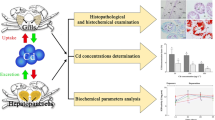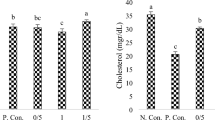Abstract
This study investigated the effect of a chitosan oligosaccharide-Ca complex (COS-Ca) on the depuration of cadmium (Cd) from Chlamys ferrari. After exposure to 0.5 mg L−1 CdCl2 for 3 or 7 d, the scallops were treated by COS-Ca prior to determination of Cd, calcium (Ca) and zinc (Zn) contents, Cd distribution in organs, malondialdehyde (MDA) content and antioxidant variables. Results showed that COS-Ca reduced Cd content in the viscera of the scallops, with highest Cd depuration rate (47%) observed on day 3. The COS-Ca concentration substantially affected Cd depuration, and the exposure to 8.75 mg L−1 COS-Ca led to significantly higher Cd depuration rate compared with those of lower COS-Ca concentrations (1.75, 3.5, 5.25, and 7.00 mg L−1). Distribution analysis of Cd in scallop organs indicated that COS-Ca significantly reduced Cd content in the kidney throughout the 5-d experiment, as well as in the gill during the early stage of Cd depuration. In addition, COS-Ca treatment decreased glutathione peroxidase (GSH-Px) activity and MDA content while increasing superoxide dismutase (SOD) and catalase (CAT) activities on different days. Our work suggested COS-Ca complex treatment as an effective method for acceleration of Cd depuration from Cd-contaminated bivalves.
Similar content being viewed by others
References
Baldisserotto, B., Kamundeb, C., Matsuo, A., and Wood C. M., 2004. Acute waterborne cadmium uptake in rainbow trout is reduced by dietary calcium carbonate. Comparative Biochemistry and Physiology, Part C, 137: 363–372.
Bebianno, M. J., Company, R., Serafim, A., Camus, L., Cosson, R. P., and Fiala-Médoni A., 2005. Antioxidant systems and lipid peroxidation in Bathymodiolus azoricus from Mid-Atlantic Ridge hydrothermal vent fields. Aquatic Toxicology, 75: 354–373.
Campbell, P. G. C., Giguère, A., Bonneris, E., and Hare, L., 2005. Cadmium-handling strategies in two chronically exposed indigenous freshwater organisms-the yellow perch (Perca flavescens) and the floater mollusc (Pyganodon grandis). Aquatic Toxicology, 72: 83–97.
Casalino, E., Calzaretti, G., Sblano, C., and Landriscina, C., 2002. Molecular inhibitory mechanisms of antioxidant enzymes in rat liver and kidney by cadmium. Toxicology, 179: 37–50.
Chan, K. W., Cheung, R. Y. H., Leung, S. F., and Wong, M. H., 1999. Depuration of metals from soft tissues of oysters (Crassostrea gigas) transplanted from a contaminated site to clean sites. Environmental Pollution, 105: 299–310.
Clara Rebouças do Amaral, M., de Freitas Rebelo, M., Paulo, Machado Torres, J., and Christian Pfeiffer, W., 2005. Bioaccumulation and depuration of Zn and Cd in mangrove oysters (Crassostrea rhizophorae, Guilding, 1828) transplanted to and from a contaminated tropical coastal lagoon. Marine Environmental Research, 59: 277–285.
Das, S. and Jana, B. B., 1999. Dose-dependent uptake and Eichhornia-induced elimination of cadmium in various organs of the freshwater mussel, Lamellidens marginalis (Linn.). Ecological Engineering, 12: 207–229.
Engel, D. W., 1999. Accumulation and cytosolic partitioning of metals in the American oyster Crassostrea virginica. Marine Environmental Research, 47: 89–102.
Franklin, N. M., Glover C. N., Nicol, J. A., and Wood, C. M., 2005. Calcium/cadmium interactions at uptake surfaces in rainbow trout: waterborne versus dietary routes of exposure. Environmental Toxicology and Chemistry, 24: 2954–2964.
Geffard, A., Amiard, J. C., and Amiard-Triquet, C., 2002. Kinetics of metal elimination in oysters from a contaminated estuary. Comparative Biochemistry and Physiology, Part C: Toxicology and Pharmacology, 131: 281–293.
Giguère, A., Campbell, P. G. C., Hare, L., and Couture, P., 2006. Sub-cellular partitioning of cadmium, copper, nickel and zinc in indigenous yellow perch (Perca flavescens) sampled along a polymetallic gradient. Aquatic Toxicology, 77: 178–189.
Gould, E. and Fowler, B. A., 1991. Scallops and pollution. In: Scallops: biology, ecology and aquaculture. Shumway, S. E. and Parsons G. J. eds., Elsevier, Amsterdam, the Netherlands, 495–515.
Guan, B., Ni, W., Wu, Z., and Lai, Y., 2009. Removal of Mn(II) and Zn(II) ions from flue gas desulfurization wastewater with water-soluble chitosan. Separation and Purification Technology, 65: 269–274.
Han, Y. and Lin, Q., 2007. Preparation of Chitobiose by hydroperoxide degradation with ultrafiltration. Journal of Bei**g Union University (Natural Science Edition), 21: 67–69.
Henrik Hansen, B., Rømma, S., Garmo, Ø. A., Pedersen, S. A., Olsvik, P. A., and Andersen, R. A., 2007. Induction and activity of oxidative stress-related proteins during waterborne Cd/Zn-exposure in brown trout (Salmo trutta). Chemosphere, 67: 2241–2249.
Inza, B., Ribeyre, F., Maury-Brachet, R., and Boudou, A., 1997. Tissue distribution of inorganic mercury, methylmercury and cadmium in the Asiatic clam (Corbicula fluminea) in relation to the contamination levels of the water column and sediment. Chemosphere, 35: 2817–2836.
Jayakumar, R., Chennazhi, K. P., Muzzarelli, R. A. A., Tamura, H., Nair, S. V., and Selvamurugan, N., 2010. Chitosan conjugated DNA nanoparticles in gene therapy. Carbohydrate Polymers, 79: 1–8.
Jo, P. G., Choi, Y. K., and Choi, C. Y., 2008. Cloning and mRNA expression of antioxidant enzymes in the Pacific oyster, Crassostrea gigas in response to cadmium exposure. Comparative Biochemistry and Physiology, Part C: Toxicology and Pharmacology, 147: 460–469.
Li, R., Zhou, Y., Ji, J., and Wang, L., 2011. Oxidative damages by cadmium and the protective effects of low-molecular-weight chitosan in the freshwater crab (Sinopotamon yangtsekiense, Bott, 1967). Aquaculture Research, 42: 506–515.
Mladenovska, K., Raicki, R. S., Janevik, E. I., Ristoski, T., Pavlova, M. J., Kavrakovski, Z., Dodov, M. G., and Goracinova, K., 2007. Colon-specific delivery of 5-aminosalicylic acid from chitosan-Ca-alginate microparticles. International Journal of Pharmaceutics, 342: 124–136.
Nemmiche, S., Chabane-Sari, D., and Guiraud, P., 2007. Role of α-tocopherol in cadmium-induced oxidative stress in Wistar rat’s blood, liver and brain. Chemico-Biological Interactions, 170: 221–230.
Ngo, H. T. T., Gerstmann, S., and Frank, H., 2010. Subchronic effects of environment-like cadmium levels on the bivalve Anodonta anatina (Linnaeus 1758): I. Bioaccumulation, distribution and effects on calcium metabolism. Toxicological and Environmental Chemistry, 93: 1788–1801.
Ojo, A. A. and Wood, C. M., 2008. In vitro characterization of cadmium and zinc uptake via the gastro-intestinal tract of the rainbow trout (Oncorhynchus mykiss): Interactive effects and the influence of calcium. Aquatic Toxicology, 89: 55–64.
Perceval, O., Couillard, Y., Pinel-Alloul, B., and Campbell, P. G. C., 2006. Linking changes in subcellular cadmium distribution to growth and mortality rates in transplanted freshwater bivalves (Pyganodon grandis). Aquatic Toxicology, 79: 87–98.
Qiu, J. W., **e, Z. C., and Wang, W. X., 2005. Effects of calcium on the uptake and elimination of cadmium and zinc in Asiatic clams. Archives of Environmental Contamination and Toxicology, 48: 278–287.
Shi, D. and Wang, W. X., 2003. Understanding the differences in Cd and Zn bioaccumulation and subcellular storage among different populations of marine clams. Environmental Science and Technology, 38: 449–456.
Silvestre, F., Dierick, J. F., Dumont, V., Dieu, M., Raes, M., and Devos, P., 2006. Differential protein expression profiles in anterior gills of Eriocheir sinensis during acclimation to cadmium. Aquatic Toxicology, 76: 46–58.
Verbost, P. M., Van Rooij, J., Flik, G., Lock, R. A. C., and Wendelaar Bonga, S. E., 1989. The movement of cadmium through freshwater trout branchial epithelium and its interference with calcium transport. Journal of experimental biology, 145: 185–197.
Wang, D. F., Sun, J. P., Xu, W., Wang, C. H., Wu, H., Hou, Y. F., and Xue, C. H., 2007. Preparation of a polysaccharidemetal complex for heavy metal removal. China Patent CN2007100-84282.8.
Wood, C. M., 2001. Toxic responses of the gill. In: Target Organ Toxicity in Marine and Freshwater Teleosts, vol. 1: Organs. Schlenk, D. W. and Benson, W. H. eds., Taylor and Francis, Washington DC, 89pp.
Wu, S. M., Shih, M. J., and Ho, Y. C., 2007. Toxicological stress response and cadmium distribution in hybrid tilapia (Oreochromis sp.) upon cadmium exposure. Comparative Biochemistry and Physiology, Part C: Toxicology and Pharmacology, 145: 218–226.
Zhang, Y., Song, J., Yuan, H., Xu Y., and He, Z., 2010. Concentrations of cadmium and zinc in seawater of Bohai bay and their effects on biomarker responses in the bivalve Chlamys farreri. Archives of Environmental Contamination and Toxicology, 59: 120–128.
Zohouri, M. A., Pyle, G. G., and Wood, C. M., 2001. Dietary Ca inhibits waterborne Cd uptake in Cd-exposed rainbow trout, Oncorhynchus mykiss Comparative Biochemistry and Physiology, Part C: Toxicology and Pharmacology, 130: 347–356.
Author information
Authors and Affiliations
Corresponding author
Rights and permissions
About this article
Cite this article
Huang, G., Sun, J., Wang, D. et al. Chitosan oligosaccharide-Ca complex accelerates the depuration of cadmium from Chlamys ferrari . J. Ocean Univ. China 11, 219–226 (2012). https://doi.org/10.1007/s11802-012-1893-y
Received:
Revised:
Accepted:
Published:
Issue Date:
DOI: https://doi.org/10.1007/s11802-012-1893-y




